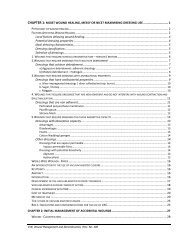permethrin intoxication of cats bibliography - Centre for Veterinary ...
permethrin intoxication of cats bibliography - Centre for Veterinary ...
permethrin intoxication of cats bibliography - Centre for Veterinary ...
Create successful ePaper yourself
Turn your PDF publications into a flip-book with our unique Google optimized e-Paper software.
CITATION YEAR COUNTRY<br />
<strong>of</strong><br />
AUTHOR<br />
Baynes, R. E. (2009). Ectoparasiticides. <strong>Veterinary</strong><br />
Pharmacology and Therapeutics. J. E. Riviere and<br />
M. G. Papich. Ames, Iowa, Wiley-Blackwell:<br />
1181-1202.<br />
Beasley, V. R. (1993). "Pesticides and pets." ACS<br />
Symposium Series 522: 344-351.<br />
Beasley, V. R. and H. L. Trammel (1989). Incidence<br />
<strong>of</strong> poisonings in small animals. Current <strong>Veterinary</strong><br />
Therapy X Small Animal Practice. J. D. Bonagura.<br />
Philadelphia, W. B. Saunders Company: 97-113.<br />
Beasley, V. R., D. C. Dorman, et al. (1990).<br />
Pyrethrum (pyrethrins) and pyrethroids. A system<br />
affected approach to veterinary toxicology. V. R.<br />
Beasley. Champaign, IL, Illinois Animal Poison<br />
In<strong>for</strong>mation Center: 111-116.<br />
Berny, P., F. Caloni, et al. (2009). "Animal poisoning<br />
in Europe. Part 2: Companion animals." The<br />
NOTES<br />
2009 USA Pyrethrins and Synthetic Pyrethroids. Safety/toxicity (pages 1194-1195) "Dermal<br />
exposure to pyrethrins and pyrethroids rarely results in systemic absorption to cause<br />
significant signs <strong>of</strong> toxicity in domestic animals, but grooming <strong>of</strong> the treated hair coat by<br />
<strong>cats</strong> can result in significant oral ingestion <strong>of</strong> pyrethroids. Cats, more so than dogs, are<br />
presented with clinical signs <strong>of</strong> toxicity, and this is <strong>of</strong>ten after the dog <strong>for</strong>mulation was<br />
inadvertently applied topically to adult <strong>cats</strong> or kittens or the untreated <strong>cats</strong> comes into<br />
physical contact with a treated dog. Recall that <strong>cats</strong> are deficient in their ability to clear<br />
chemicals by hepatic glucuronidation. This explains why <strong>cats</strong> are more sensitive than<br />
dogs to pyrethroids. The dog-only spot-on flea and tick products can contain as much<br />
as 45-65% <strong>permethrin</strong>, which at this concentration can be very harmful to most <strong>cats</strong><br />
(Meyer 1999). Not only is <strong>permethrin</strong> toxicity in <strong>cats</strong> a great concern, but so is<br />
phenothrin toxicity in <strong>cats</strong>. Phenothrin, a Type 1 pyrethroid similar to <strong>permethrin</strong>, was<br />
originally approved as a spot-on product with 85.7% phenothrin <strong>for</strong> <strong>cats</strong>. These<br />
products were cancelled in 2005 by the manufacturer because <strong>of</strong> the adverse effects<br />
and numerous deaths in feline patients."<br />
1993 USA As compared to much older products containing ''classical pesticides'', such as the<br />
rodenticide warfarin and the insecticide carbaryl, many newer <strong>for</strong>mulations are more<br />
hazardous to domestic animals in urban and suburban environments. Although<br />
progress has been marked in the area <strong>of</strong> insecticide baits <strong>for</strong> use in homes, at least<br />
one fly bait which is particularly lethal to dogs is still widely available. In the case <strong>of</strong><br />
rodenticides, recent experience has reflected generally negative progress with regard<br />
to small animal safety. Indeed, some products relatively new to the marketplace<br />
routinely cause prolonged suffering, necessitate expensive and <strong>of</strong>ten ineffective<br />
therapies, and can induce permanent organ damage despite vigorous treatment <strong>of</strong> the<br />
inadvertently exposed pet animal.<br />
1989 USA Pyrethrin and pyrethroid insecticides "In 1986, pyrethrin calls to the center with<br />
regard to <strong>cats</strong> were more numerous than <strong>for</strong> any other generic; over 60 per cent <strong>of</strong><br />
these calls were regarded as toxicosis or suspected toxicosis. Six <strong>of</strong> the feline calls<br />
assessed as suspected toxicosis were accompanied by deaths. Dogs appear to be<br />
affected less <strong>of</strong>ten." Fenvalerate and DEET Cats were most <strong>of</strong>ten affected by<br />
exposure to Hartz Blockade which contained fenvalerate and DEET.<br />
1990 USA<br />
2009 France Among veterinary drugs, external parasiticides are the single most common cause <strong>of</strong><br />
poisoning with many cases involving adverse reactions to pyrethroids, particularly<br />
PERMETHRIN INTOXICATION OF CATS 28 Novermber 2009 Page 6 <strong>of</strong> 26






